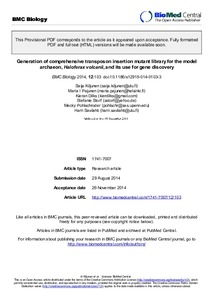Generation of comprehensive transposon insertion mutant library for the model archaeon, Haloferax volcanii, and its use for gene discovery
Mechthild Pohlschroder; Maria I Pajunen; Kieran Dilks; Stefanie Storf; Harri Savilahti; Saija Kiljunen
https://urn.fi/URN:NBN:fi-fe2021042715182
Tiivistelmä
BackgroundArchaea share fundamental properties with bacteria and eukaryotes. Yet, they also possess unique attributes, which largely remain poorly characterized. Haloferax volcanii is an aerobic, moderately halophilic archaeon that can be grown in defined media. It serves as an excellent archaeal model organism to study the molecular mechanisms of biological processes and cellular responses to changes in the environment. Studies on haloarchaea have been impeded by the lack of efficient genetic screens that would facilitate the identification of protein functions and respective metabolic pathways.ResultsHere, we devised an insertion mutagenesis strategy that combined Mu in vitro DNA transposition and homologous-recombination-based gene targeting in H. volcanii. We generated an insertion mutant library, in which the clones contained a single genomic insertion. From the library, we isolated pigmentation-defective and auxotrophic mutants, and the respective insertions pinpointed a number of genes previously known to be involved in carotenoid and amino acid biosynthesis pathways, thus validating the performance of the methodologies used. We also identified mutants that had a transposon insertion in a gene encoding a protein of unknown or putative function, demonstrating that novel roles for non-annotated genes could be assigned.ConclusionsWe have generated, for the first time, a random genomic insertion mutant library for a halophilic archaeon and used it for efficient gene discovery. The library will facilitate the identification of non-essential genes behind any specific biochemical pathway. It represents a significant step towards achieving a more complete understanding of the unique characteristics of halophilic archaea.
Kokoelmat
- Rinnakkaistallenteet [19207]
